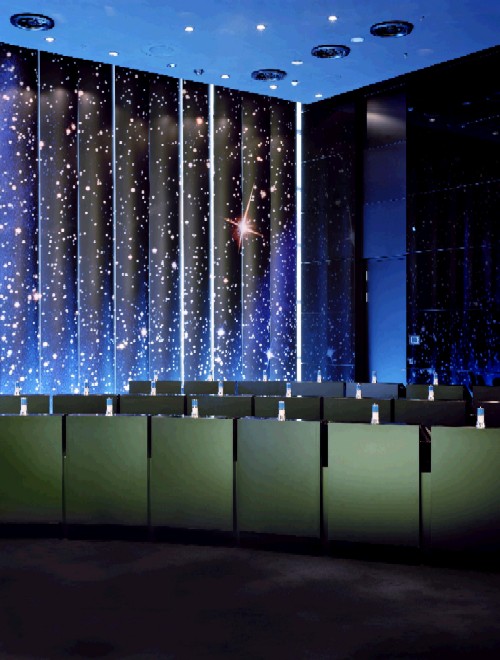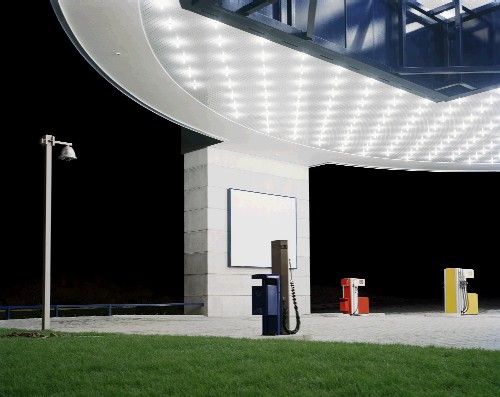Reviews & Articles
New Photographs by Julian Faulhaber
Valerie C DORAN
at 10:25am on 30th May 2009


Among the visual cacophony of this month’s Hong Kong Art Fair 09, a clear, pure note was sounded by the collective presence of a number of stunning, large-format photographic works by a diverse range of Asian and European artists, including Hiroshi Sugimoto, Jung Lee, Massimo Vitali and Candida Hofer. In stark contrast to the leering faces, exposed female body parts and overly mixed-up media that characterized far too large a portion of the art on show at the fair, these photographs exuded a tantalizingly ambiguous quietude. In these captured vistas of natural landscape or architectural interiors, the human presence was always more of a question than a statement.
Across the street from the fair, the Goethe Institute added an interesting, other dimension to this photographic discourse, with the opening of an exhibition of new, large-format works by the young German photographer Julian Faulhaber (b. 1975). Over the last few years Faulhaber has emerged as an artist with his own disquieting narrative of the post-industrial landscape. In his tightly cropped, geometrically precise, and luridly coloured images, the protagonists are among the most banal elements of our constructed environment: the exit area of a petrol station, the interior of a fast-food restaurant, the shiny front of an automat’s vending machines. Bathed in artificial light and strangely pristine, these clearly human constructs yet seem utterly devoid of the human presence, and hover on the edge of hyper-reality. Yet these are not digitally contrived images, but rather real photographs of real places taken in real time. The heightened sense of artificiality comes from Faulhaber’s quest to photograph buildings and interiors whose construction has only just been completed, before they are actually turned over to human use.
Taking great care to remove any signage or other traces of the human presence, and selecting angles of focus outside of the usual framing of such spaces, Faulhaser photographs them using a large format camera and the on-site available light—usually fluorescent. The resulting effect has the constructed artificiality of a stage set, and for this reason Faulhaber has been compared to artists such as Lois Renner and Oliver Boberg, who create constructed montages and then photograph them. Yet, Faulhaber’s lineage would seem to lie closer to the German contemporary documentary tradition exemplified in the great minimalist photographers Bernd and Hilla Becher and in later artists such as Andreas Gurtsky. In Faulhaber’s work we are reminded again of how much still-unarticulated strangeness and wonder there is in the world of things around us, and in the psychological terrain that lies between things and their semi-conscious creators—ourselves. However disquieting it may be, the rigorousness of Faulhaber’s own way of seeing—like that of the Bechers’, and of Sugimoto—brings to mind lines from the Austrian poet Rainer Maria Rilke:
"And these Things
which live by perishing, know you are praising them; transient,
they look to us for deliverance: us, the most transient of all.”
(from Duino Elegies)
Exhibition: 《New photographs by Julian Faulhaber》
Date: 11.5. - 13.6.2009
Venue: Goethe-Gallery, Goethe-Institut Hong Kong, 14/F Hong Kong Arts Centre, Wanchai
Enquiries: 852 2802 0088
Website: http://www.goethe.de/ins/cn/hon/ver/en4514360v.htm
Across the street from the fair, the Goethe Institute added an interesting, other dimension to this photographic discourse, with the opening of an exhibition of new, large-format works by the young German photographer Julian Faulhaber (b. 1975). Over the last few years Faulhaber has emerged as an artist with his own disquieting narrative of the post-industrial landscape. In his tightly cropped, geometrically precise, and luridly coloured images, the protagonists are among the most banal elements of our constructed environment: the exit area of a petrol station, the interior of a fast-food restaurant, the shiny front of an automat’s vending machines. Bathed in artificial light and strangely pristine, these clearly human constructs yet seem utterly devoid of the human presence, and hover on the edge of hyper-reality. Yet these are not digitally contrived images, but rather real photographs of real places taken in real time. The heightened sense of artificiality comes from Faulhaber’s quest to photograph buildings and interiors whose construction has only just been completed, before they are actually turned over to human use.
Taking great care to remove any signage or other traces of the human presence, and selecting angles of focus outside of the usual framing of such spaces, Faulhaser photographs them using a large format camera and the on-site available light—usually fluorescent. The resulting effect has the constructed artificiality of a stage set, and for this reason Faulhaber has been compared to artists such as Lois Renner and Oliver Boberg, who create constructed montages and then photograph them. Yet, Faulhaber’s lineage would seem to lie closer to the German contemporary documentary tradition exemplified in the great minimalist photographers Bernd and Hilla Becher and in later artists such as Andreas Gurtsky. In Faulhaber’s work we are reminded again of how much still-unarticulated strangeness and wonder there is in the world of things around us, and in the psychological terrain that lies between things and their semi-conscious creators—ourselves. However disquieting it may be, the rigorousness of Faulhaber’s own way of seeing—like that of the Bechers’, and of Sugimoto—brings to mind lines from the Austrian poet Rainer Maria Rilke:
"And these Things
which live by perishing, know you are praising them; transient,
they look to us for deliverance: us, the most transient of all.”
(from Duino Elegies)
Exhibition: 《New photographs by Julian Faulhaber》
Date: 11.5. - 13.6.2009
Venue: Goethe-Gallery, Goethe-Institut Hong Kong, 14/F Hong Kong Arts Centre, Wanchai
Enquiries: 852 2802 0088
Website: http://www.goethe.de/ins/cn/hon/ver/en4514360v.htm
